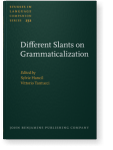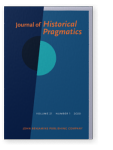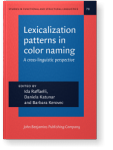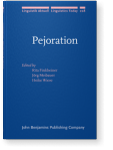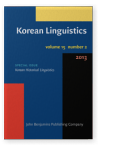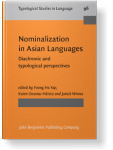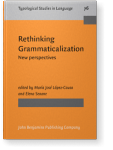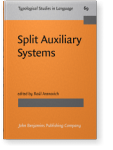Seongha Rhee
List of John Benjamins publications for which Seongha Rhee plays a role.
Journal
2023 Chapter 8. Repetitive constructions and stance-marking: The case in Korean Discourse Phenomena in Typological Perspective, Barotto, Alessandra and Simone Mattiola (eds.), pp. 201–227 | Chapter
Korean has highly formulaic patterns of repeating a sentence two or more times with a variation of speech level indicated by the sentence-final particles. The repetition usually involves progressive downward modulation of the speech level from more formal to less formal. The repeated sentences… read more
2023 Chapter 8. On the development of discourse markers from elliptical structures Different Slants on Grammaticalization, Hancil, Sylvie and Vittorio Tantucci (eds.), pp. 198–236 | Chapter
Korean has a group of DMs that developed from sentential fragments through ellipsis (EDMs), i.e., those that were morpho-syntactically incapable of standing alone. They carry diverse functions across discourse domains. In particular, they tend to mark the speaker’s affect, and this development is… read more
2021 Chapter 3. On divergent paths and functions of ‘background’-based discourse markers in Korean Studies at the Grammar-Discourse Interface: Discourse markers and discourse-related grammatical phenomena, Haselow, Alexander and Sylvie Hancil (eds.), pp. 77–100 | Chapter
This paper analyzes two polyfunctional discourse markers (DMs) in Korean, kulssey and kuntey, which share lexical and grammatical sources, with the meaning of ‘at the time’ for kulssey and ‘at the place’ for kuntey. They denote the background of an action/event (‘in such circumstances’), which is… read more
2020 Pseudo-hortative and the development of the discourse marker eti poca (‘well, let’s see’) in Korean Journal of Historical Pragmatics 21:1, pp. 53–82 | Article
Hortative constructions are good sources of discourse markers (dms) because they have an engaging effect on the addressee. Such an engaging illocutionary effect enables hortative-based dms to acquire diverse functions, such as attracting and maintaining the addressee’s attention and foiling the… read more
2019 Lexicalization patterns in color naming in Korean Lexicalization patterns in color naming: A cross-linguistic perspective, Raffaelli, Ida, Daniela Katunar and Barbara Kerovec (eds.), pp. 109–132 | Chapter
Korean has a large inventory of color terms lexicalized through diverse strategies. Sound symbolism is one of the most determinative factors. Sound symbolism operative in color naming includes vowel polarity, consonant tensing and aspiration, prefixation of intensifiers, phonetic extension, and… read more
2017 Multifaceted gustation: Systematicity and productivity of taste terms in Korean Food and terminology: Expressing sensory experience in several languages, Temmerman, Rita and Danièle Dubois (eds.), pp. 38–65 | Article
Korean has a large number of taste terms and the paradigm is continuously expanding since the lexicalization operates systematically on a few robust principles. Based on the taste terms collected from lexicons, dictionaries, web-postings, and elsewhere, we classified the terms and analyzed the… read more
2016 Pejoratives in Korean Pejoration, Finkbeiner, Rita, Jörg Meibauer and Heike Wiese (eds.), pp. 301–324 | Article
This paper analyzes the patterns of pejoration-marking in Korean. The speaker’s pejorative attitude is realized as diverse morpho-syntactic devices (Koo 2004). The most common devices of pejoration-marking fall under the following six categories classified according to the semantics of the source… read more
2016 LP and RP in the development of discourse markers from “what” in Korean Periphery – Diachronic and Cross-Linguistic Approaches, Higashiizumi, Yuko, Noriko O. Onodera and Sung-Ock S. Sohn (eds.), pp. 255–281 | Article
This paper describes the development of two different DMs that emerged from the interrogative pronoun mwe (literally ‘what’). Both DMs acquired discursive functions as their source structures were used rhetorically (i.e., not to solicit an answer but to elicit attention). The DM mwe shifted from… read more
2013 Chapter 13. Grammaticalization of space in Korean and Japanese Shared Grammaticalization: With special focus on the Transeurasian languages, Robbeets, Martine and Hubert Cuyckens (eds.), pp. 287–316 | Chapter
Spatial concepts are central for human language and cognition. They can either be the source or the target of grammaticalizations. In this paper, we compare grammaticalization in Japanese and Korean in four core areas related to space: case particles and related particles, relational nouns,… read more
2011 Nominalization and stance marking in Korean Nominalization in Asian Languages: Diachronic and typological perspectives, Yap, Foong Ha, Karen Grunow-Hårsta and Janick Wrona (eds.), pp. 393–422 | Article
This paper investigates the stance-marking function of nominalizers in Korean. This function is a product of grammaticalization processes whereby the nominalizers acquired special meanings from subjectification and intersubjectification of the interlocutors. Diverse stances are marked by these… read more
2008 On the rise and fall of Korean nominalizers Rethinking Grammaticalization: New perspectives, López-Couso, María José and Elena Seoane (eds.), pp. 239–264 | Article
This paper addresses the origin and development of the system of Korean nominalizers from Old to Present-day Korean, paying special attention to their sources, the semantic changes they underwent over time, the competition between various nominalizers for the same functional domain, and the… read more
2007 Particle selection in Korean auxiliary formation Split Auxiliary Systems: A cross-linguistic perspective, Aranovich, Raúl (ed.), pp. 237–254 | Article


